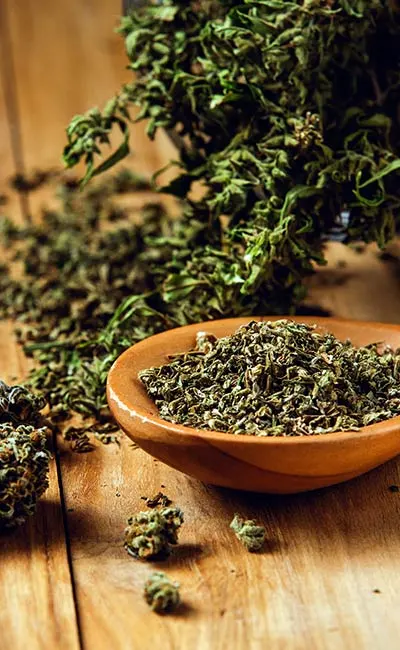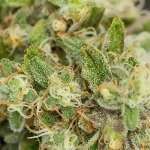
How to Differentiate Among Key Cannabinoids
Cannabinoids in cannabis are a variety of chemical compounds that act on receptors in the human endocannabinoid system to create different effects. Moreover, they work synergistically with one another and with other chemical compounds to enhance the overall experience – a phenomenon known as the entourage effect. Here, we compare the best-known cannabinoids.
Tetrahydrocannabinol (THC)
Tetrahydrocannabinol (THC) is the primary psychoactive cannabinoid compound in cannabis, known for inducing the euphoric high associated with marijuana. By binding to brain and central nervous system cannabinoid receptors, notably CB1 receptors, THC alters neurotransmitter release, impacting perception, mood, and cognition. Among over 100 cannabinoids in cannabis, THC stands out for its potent psychoactive effects and extensive research attention.
Impact of Tetrahydrocannabinol (THC)
Tetrahydrocannabinol (THC) profoundly affects the body and mind by binding to cannabinoid receptors in the brain and central nervous system. This interaction alters neurotransmitter release, leading to psychoactive effects such as euphoria, relaxation, and altered perception. However, higher doses can induce adverse effects like anxiety and impaired coordination, necessitating responsible consumption.
Common Uses of Tetrahydrocannabinol (THC)
THC is used recreationally and medicinally. Recreational users consume THC for relaxation, stress relief, and mood enhancement. Medically, THC is used to manage chronic pain, nausea, muscle spasms, and appetite stimulation in conditions like cancer and HIV/AIDS. Ongoing research on this cannabinoid explores its potential in treating epilepsy, PTSD, insomnia, and neurodegenerative diseases.

Cannabidiol (CBD)
Cannabidiol (CBD) is a prominent cannabinoid found in cannabis known for its therapeutic potential and non-intoxicating effects. Unlike THC, CBD does not induce a high but instead interacts with the endocannabinoid system to produce various medicinal benefits. It modulates neurotransmitter release and receptor activity, influencing pain perception, mood regulation, and immune response. CBD has gained widespread attention for its diverse therapeutic applications and minimal side effects.
Impact of Cannabidiol (CBD)
Cannabidiol (CBD) impacts the body and mind by interacting with the endocannabinoid system (like any other cannabinoid). It modulates neurotransmitter release, and has therapeutic effects such as pain relief, stress reduction, and anti-inflammatory properties. CBD‘s non-intoxicating nature makes it appealing for individuals seeking relief without the psychoactive effects commonly associated with cannabis consumption.
Common Uses of Cannabidiol (CBD)
CBD has a wide range of medical purposes. It can alleviate chronic pain, reduce anxiety and depression symptoms, and improve sleep quality. Additionally, CBD has shown promise in managing conditions such as epilepsy, arthritis, and PTSD. Its anti-inflammatory properties make it valuable for treating skin conditions like acne and eczema. With ongoing research, the potential applications of CBD continue to expand, highlighting its versatility as a therapeutic agent.
Cannabigerol (CBG)
Cannabigerol (CBG) is a cannabinoid found in cannabis that is gaining attention for its potential therapeutic benefits. Although less abundant than THC and CBD, CBG plays a crucial role as the precursor to other cannabinoids. It interacts with the endocannabinoid system, influencing various physiological processes such as mood, appetite, and pain perception. CBG is non-intoxicating and does not produce the psychoactive effects associated with THC, making it an appealing option for medicinal use.
Impact of Cannabigerol (CBG)
Cannabigerol (CBG) interacts with the endocannabinoid system to modulate neurotransmitter release and receptor activity. This interaction may result in therapeutic effects such as pain relief, anti-inflammatory properties, and potential neuroprotective effects. CBG‘s non-intoxicating nature distinguishes it from THC, offering medicinal benefits without the psychoactive side effects.
Common Uses of Cannabigerol (CBG)
CBG is being researched for its potential in treating various medical conditions. It shows promise in managing chronic pain, inflammation, and gastrointestinal disorders like irritable bowel syndrome (IBS). CBG‘s antibacterial properties make it valuable for combating infections, while its neuroprotective effects suggest potential applications in treating neurodegenerative diseases like Huntington’s and Parkinson’s. As research continues, CBG‘s therapeutic potential continues to be explored, highlighting its importance as a cannabinoid with diverse medicinal properties.
Cannabinol (CBN)
Cannabinol (CBN) is a cannabinoid found in cannabis that is garnering interest for its potential therapeutic properties. Formed from the degradation of THC, CBN is often present in aged or oxidized cannabis. While it is less abundant than THC or CBD,
exhibits unique effects on the endocannabinoid system. It interacts with cannabinoid receptors, influencing sleep, pain perception, and appetite regulation. CBN is non-intoxicating and does not produce the psychoactive effects associated with THC, making it a promising option for medicinal use.
Impact of Cannabinol (CBN)
Cannabinol (CBN) interacts with the endocannabinoid system to modulate neurotransmitter release and receptor activity. This interaction may result in therapeutic effects such as sedation, pain relief, and potential antibacterial properties. CBN‘s non-intoxicating nature distinguishes it from THC, offering medicinal benefits without the psychoactive side effects commonly associated with cannabis consumption.
Common Uses of Cannabinol (CBN)
CBN is being explored for its potential in treating various medical conditions, particularly those related to sleep and pain. This cannabinoid is often used as a sleep aid due to its sedative effects, and has shown promise in managing insomnia and sleep disorders. Additionally, CBN may offer relief from pain and inflammation, making it a valuable option for individuals with chronic pain conditions. Its potential antibacterial properties also suggest applications in combating infections. As research into CBN continues, its therapeutic potential continues to be elucidated, highlighting its importance as a cannabinoid with diverse medicinal properties.

Tetrahydrocannabivarin (THCv)
Tetrahydrocannabivarin (THCv) is a lesser-known cannabinoid found in cannabis that is gaining attention for its potential therapeutic effects. Similar to THC, THCv interacts with the endocannabinoid system, albeit with differing effects. While THC is known for its psychoactive properties, THCv is non-intoxicating and may even counteract some of THC‘s effects. Research suggests that THCv may have potential applications in managing conditions such as obesity, diabetes, and epilepsy. However, further studies are needed to fully understand its mechanisms of action and therapeutic potential.
Impact of Tetrahydrocannabivarin (THCv)
Tetrahydrocannabivarin (THCv) interacts with the endocannabinoid system, exerting effects on neurotransmitter release and receptor activity. Unlike THC, THCv is non-intoxicating and may even suppress appetite, making it a potential candidate for managing obesity and related metabolic disorders. Additionally, THCv has shown promise in reducing seizures in epilepsy patients. Its distinct effects make it an intriguing subject for further research into its therapeutic potential and applications.
Common Uses of Tetrahydrocannabivarin (THCv)
THCv is being investigated for its potential to treat various medical conditions. It may offer benefits in managing obesity by suppressing appetite and promoting weight loss. Additionally, THCv has shown anticonvulsant properties, suggesting potential applications in epilepsy treatment. Its unique effects on the endocannabinoid system make it a promising candidate for further research into its therapeutic uses. However, more studies are needed to elucidate its mechanisms of action and determine its efficacy in clinical settings.
9-Tetrahydrocannabinol acid (THCa)
9-Tetrahydrocannabinol acid (THCa) is a non-intoxicating cannabinoid found in raw, unheated cannabis plants. Unlike THC, THCa does not produce psychoactive effects when consumed. Instead, it serves as the precursor to THC and undergoes decarboxylation, a process that occurs when cannabis is heated, converting THCa into THC. While THCa does not directly interact with cannabinoid receptors in the same way as THC, it may still have therapeutic potential due to its influence on the endocannabinoid system. Research suggests that THCa may possess anti-inflammatory, neuroprotective, and antiemetic properties, making it a subject of interest for medicinal applications.
Impact of 9-Tetrahydrocannabinol acid (THCa)
9-Tetrahydrocannabinol acid (THCa) does not directly bind to cannabinoid receptors and does not induce psychoactive effects. However, it serves as the precursor to THC and undergoes decarboxylation when exposed to heat, converting into THC. While THCa’s effects are not well-understood compared to THC, it may still influence the endocannabinoid system and possess therapeutic properties. Research suggests that THCa may have anti-inflammatory, neuroprotective, and antiemetic effects, though more studies are needed to fully understand its impact and potential applications.
Common Uses of 9-Tetrahydrocannabinol acid (THCa)
THCa is primarily found in raw cannabis plants and is not commonly used in its isolated form. However, some individuals may consume raw cannabis or cannabis juice to benefit from the potential therapeutic effects of THCa. Research into THCa’s medicinal properties is ongoing, with studies suggesting potential applications in conditions such as inflammation, neurodegenerative diseases, and nausea. While THCa is not psychoactive, it may still offer health benefits and is an area of interest for further investigation.

Terpenes & Cannabinoids: Entourage Effect
Terpenes are aromatic compounds in plants that give them unique aroma and flavor. They may also work synergistically with cannabinoids and other terpenes to enhance the overall effect of the cannabis – a phenomenon commonly referred to as the entourage effect.
Carene
- Aroma: Carene has a sweet, earthy aroma with hints of pine and woodiness.
- Flavor: Its flavor profile is a piney, woody taste with subtle citrus undertones.
- Effects: Carene is known for its potential anti-inflammatory properties and may contribute to feelings of relaxation and stress relief.
D-Limonene
- Aroma: D-Limonene boasts a bright, citrusy aroma reminiscent of lemon or orange zest.
- Flavor: Its flavor profile features zesty citrus notes with a tangy, refreshing quality.
- Effects: D-Limonene is associated with mood elevation, stress relief, and potential anti-anxiety effects. It may also exhibit antimicrobial properties.
Geraniol
- Aroma: Geraniol offers a floral and fruity aroma with hints of rose, geranium, and citrus.
- Flavor: Its flavor profile is floral and fruity, often compared to roses or sweet fruits like peach or raspberry.
- Effects: Geraniol has antioxidant and anti-inflammatory properties with potential for stress relief and mood enhancement.
Humulene
- Aroma: Humulene has an earthy, woody fragrance with subtle spicy and herbal notes.
- Flavor: Its flavor is earthy and herbal, with hints of woodiness and spice.
- Effects: Humulene may exhibit anti-inflammatory properties and is commonly associated with appetite suppression. It may also contribute to feelings of relaxation and stress relief.
Linalool
- Aroma: Linalool has a floral fragrance with hints of lavender, rose, and spice.
- Flavor: Its flavor profile is floral and slightly sweet, with subtle hints of spice.
- Effects: Linalool is known for its calming and sedative effects, making it beneficial for relaxation, stress relief, and promoting sleep.
Myrcene
- Aroma: Myrcene has a musky, earthy fragrance with notes of ripe fruits like mango and citrus.
- Flavor: Its flavor is earthy and herbal, with hints of fruity sweetness.
- Effects: Myrcene enhances the effects of cannabinoids like THC, contributing to a relaxed, sedative experience. It may also exhibit anti-inflammatory and analgesic properties.
Terpineol
- Aroma: Terpineol offers a floral aroma with hints of lilac, citrus, and pine.
- Flavor: Its flavor profile is floral and slightly sweet, with subtle citrus and pine undertones.
- Effects: Terpineol may have sedative and relaxing effects, making it useful for stress relief and promoting sleep. It may also exhibit antioxidant and antimicrobial properties.
Terpinolene
- Aroma: Terpinolene has a fresh, herbal aroma with hints of pine, floral, and citrus.
- Flavor: Its flavor is herbal and slightly floral, with subtle citrus notes.
- Effects: Terpinolene is known for its uplifting and energizing effects, often promoting creativity and focus. It may also have antioxidant and antibacterial properties.
α-Pinene
- Aroma: α-Pinene has a fresh, piney aroma reminiscent of pine forests.
- Flavor: Its flavor profile is herbal and piney, with hints of earthiness.
- Effects: α-Pinene may improve focus, alertness, and memory retention. It may also exhibit anti-inflammatory and bronchodilator properties.
β-Caryophyllene
- Aroma: β-Caryophyllene has a spicy, woody aroma with hints of pepper and cloves.
- Flavor: Its flavor is spicy and peppery, with subtle woody undertones.
- Effects: β-Caryophyllene has anti-inflammatory and analgesic properties. It may also exhibit potential for stress relief and mood enhancement.

Conclusion
In conclusion, understanding the key cannabinoids found in cannabis is essential for both recreational and medicinal users. These compounds interact with the body’s endocannabinoid system, producing various effects that contribute to the overall cannabis experience.
While THC is renowned for its psychoactive properties, CBD offers therapeutic benefits without intoxication. CBG, CBN, THCv, and THCa are emerging as promising cannabinoids with diverse medicinal potentials.
Additionally, terpenes play a crucial role in the entourage effect, enhancing the overall effects of cannabis. By recognizing the unique characteristics of each cannabinoid and terpene, individuals can tailor their cannabis consumption to suit their needs and preferences, whether for relaxation, pain relief, or therapeutic purposes.
Continued research into these compounds will further elucidate their mechanisms of action and expand their applications in the medical field, highlighting the importance of comprehensive cannabinoid education and exploration.
Disclaimer: The content shared here does not serve as a replacement for expert medical guidance, diagnosis, or treatment. It’s essential to seek counsel from a certified healthcare provider who can offer tailored advice suitable for your individual medical needs.






